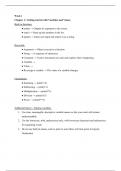Summary
Summary - Introduction to Programming for CIW (800873-B-6) (800873-B-6)
- Course
- Institution
This document provides a comprehensive summary of the course “Introduction to Programming for CIW (800873-B-6)”. The summary covers essential concepts and programming skills taught in the course. It includes an overview of programming fundamentals, such as variables, data structures and control...
[Show more]



